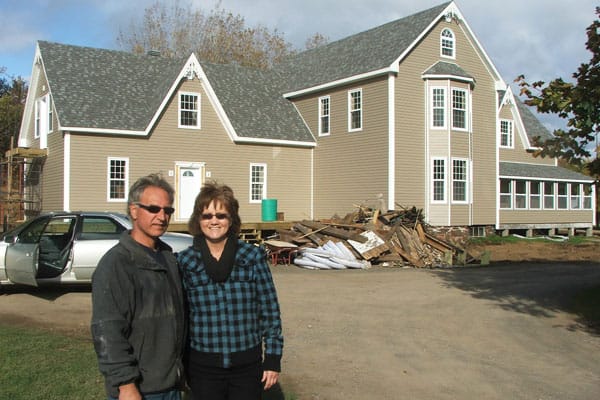The old ghosts of the Big House in Dalhousie, NB, are replaced by a bright light, and hope for the future.
Perhaps one of the most startling models of economic revitalization in the country is Chemainus, BC. In short, the BC forest industry was struggling in the early ’80s; the mill, which was the town’s major employer, shut down. The future looked bleak. Partially as an economic strategy and partially to motivate people to stay in the town, a project to beautify the town through murals on buildings was initiated.
Artists were commissioned, buildings were decorated and almost overnight, the economy blossomed. The spectacular murals spawned a thriving tourist industry in the milltown; new businesses created a diversified economy; and mill workers, thanks to jobs created through tourism industry spinoffs, were able to stay in their hometown. Chemainus has served as a model for other communities struggling with downturned economies.
My hometown, Dalhousie, NB, mirrors Chemainus in its early stage. After nearly 80 years of operation, the paper mill, the major employer, shut down in 2008, and subsequently other employers took down their shingles. Initially, a dark aura hovered over the town and its residents. Situated on one of the most spectacularly beautiful coasts of New Brunswick, the town overlooks the Bay of Chaleur, and across the water to the mountains of the Gaspé. But beauty alone doesn’t put meals on the table.

What is it that perks you up when you feel down in the dumps? When I was in the depths of despair my Dad used to tell me to wash my face, hum a song and I’d feel better. It works! On a recent visit I noted that Dalhousie is washing its face—people seem to have the time and wherewithal to spruce up their homes and gardens. The town looks good. And it is humming with various forms of artistic activity—from opera to rock, comedy, highland dancing and more.
Central to the buzz are Dawn and Walter Kenny, a young couple who exemplify the grit and determination of North Shorers. Both were born and educated in Dalhousie, and have worked there all their lives, Walter at the mill and Dawn at the post office. When the economy nosedived, they refused to leave for greener grass elsewhere. Instead, they examined their skills, wallets and community, and decided to risk embarking on a new adventure. In 2008 they bought a big, old house in need of much attention and dreamed of opening Arts Restigouche, a school for fine and performing arts.
The house isn’t just any old run-down house—it’s reputed to be the oldest in Dalhousie. Built around 1830, the house was purchased by Dugald Stewart in 1841 and remained in the Stewart family until bought by the Kennys. My family, connected to the Stewarts by kinship, lived on a section of the Stewart acreage.
Most of my childhood memories surround dodging Aunt Maisie, the grand dame of the Big House, and the granny of most of my playmates. Road signs at that time (speed, parking) had L.A. written in the bottom corner. We were told that it meant Legal Authority, and we assumed that was Aunt Maisie’s title. As kids we terrorized her. We seemed to be attracted more to the things we shouldn’t do than to those we should—jumping from rafters in the hay mow, hotwiring the jitney, disturbing the pigs in the orchard, torturing the bull, irritating the mink.
Even now I shake at the blast of a shotgun, expecting to feel the sting of rock salt from Aunt Maisie’s! I swear she could see round buildings and through walls! She eked out the punishment: clean the barn for a week; weed the gardens, or pick potato bugs off the plants.
Apart from shaking in our boots any time Aunt Maisie appeared after our wrongdoing, the Big House was central to social activity at The Point. Church functions, wedding receptions and family reunions were hosted in the house and gardens. Children were banned from most rooms of the house all the time, but particularly in the kitchens at these times, so it became one of our games to try and sneak something sweet from the larder. A blast from Aunt Maisie’s lungs sent us running.
On my recent visit to Dalhousie, Aunt Maisie’s ghost was put to rest as Dawn talked about their dreams for the Big House. The renovation took two years—it was gutted in 2009 and rebuilt in 2010. Walter did most of the restorative work himself, helped by family and friends. The outside closely resembles the original; inside is a major contrast to my own younger days in the house.
It is designed to attract groups of adults and young people to sing, dance and play in every room, accommodating 50 people for performances, meals and workshops, and 32 for sleeping. The building is well suited to meetings or workshops in addition to artistic activities. Plans are in the mill to have the barn turned into a theatre.
Dawn has a good sense of business and is determined to make the Arts Restigouche School the only private arts school in Atlantic Canada. She has a confident, professional manner. Well-qualified instructors are hired to teach the various camps. And Walter is one heck of a cook!
The Kennys have all the ingredients to make the Arts Restigouche School a success. They both have respect for the past, they have pride and believe in their community, and they have the stick-to-it-iveness required to make their dreams come true. The ripple effect will undoubtedly take place; other businesses will arise out of the mill ashes. As the old mill building gets torn down, townspeople talk of a boardwalk along the beautiful Restigouche River with businesses behind. Dalhousie has a deep port capable of handling cruise and cargo ships.
The Big House is on the North Shore snowmobile trail, so it can attract special groups in the well-defined winters. The beach will call people into the cool Bay of Chaleur on hot summer days. And the area will echo with people learning and performing artistic skills inside and outside the walls of the house.
At one time, the Dalhousie shores attracted the great and the near-great. Father of Confederation, Sir John A. Macdonald, and his wife visited the no-longer-standing Inch Arran House situated not far from the current Arts Restigouche School. People stayed in Dalhousie en route to salmon fishing on the Restigouche River, and others from all over North America simply enjoyed the scenery and the people as they took much-needed vacations from the pressures of city living.
I have no doubt that Dalhousie will rise and once again be a destination for travellers from around the world. As Lucien the Millworker (aka Marshall Button, the Dalhousie-raised actor and playwright) says, “Dere’s no shore like the Nort’ Shore, dat’s for shore.”
For information on Arts Restigouche programs, go to artsrestigouche.com or call (506) 684-1801. Also: check out the annual Bon Ami Festival in Dalhousie. Information: bonamifestival.com.
